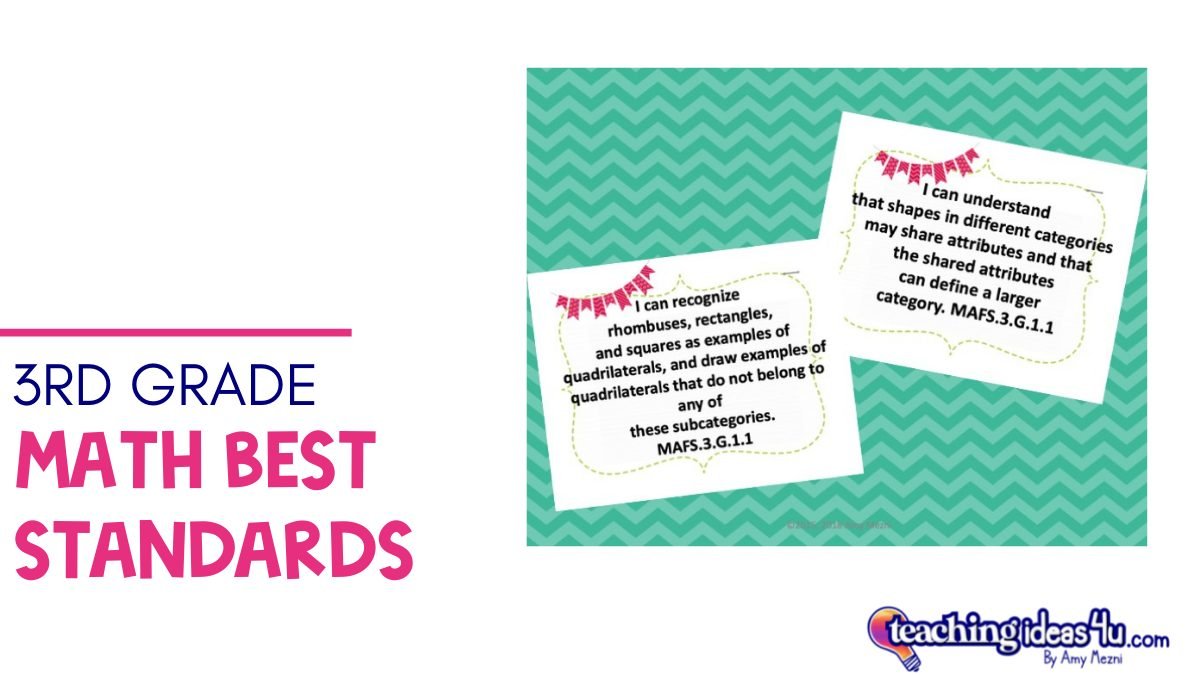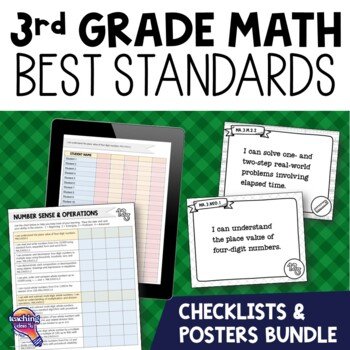3rd Grade Math BEST Standards
What can third-grade teachers expect from the new Florida BEST Standards for math? How do they compare to the MAFS standards? What are third-grade students now expected to learn?
Set your mind at ease, because I am going to break down the new third-grade Math BEST standards. In this post, I will quickly analyze the changes and how they will affect your classroom.
How are the BEST Standards organized?
In third grade, Math BEST standards are divided into 7 subcategories, while the MAFS had 6:
Number Sense and Operations - Previously Numbers and Operations in Base 10
Measurement
Data Analysis and Probability – These standards were split into their own category. They were previously in Measurement and Data.
Algebraic Reasoning – Was Operations and Algebraic Thinking
Geometric Reasoning – Previously Geometry
Fractions – In MAFS, these standards were called Numbers & Operations: Fractions.
Mathematical Practice – This is now called Mathematical Thinking and Reasoning. These are the global standards students are expected to use throughout their school career.
The Changes
Honestly, there are not many major changes to the math standards. A lot of the updates feel like changes in wording more than an actual change in concepts taught. Third grade does add a few new skills, and a few others are slightly altered.
For ease of organization, I am going to discuss the new standards by subcategory.
Mathematical Thinking & Reasoning
These standards are the overarching skills students are meant to improve throughout their math classes.
The word precision was changed to fluency (MA.K12.MTR.3.1 - Complete tasks with mathematical fluency.)
The big changes are in what was removed:
“Create models with mathematics.”
“Select and use appropriate mathematical tools strategically.”
More discussion on these two things later. These two standards seem to tie into many of the standards that either had their wording changed or were omitted in BEST.
Number Sense and Operations
This subcategory kept its MAFS standards and added a whole section on place value.
In MAFS, students were expected to round numbers to the nearest ten. That standard remained, but is now just one concept under the core standard MA.3.NSO.1 – Understand place value of four-digit numbers. The place value subskills that were added are:
3.NSO.1.1 – Read and write numbers from 0 to 10,000 using standard form, expanded form, and word form.
3.NSO.1.2 – Compose and decompose four-digit numbers in multiple ways using thousands, hundreds, tens, and ones. Demonstrate each composition or decomposition using objects, drawings, and expressions or equations.
3.NSO.1.3 – Plot, order, and compare whole numbers up to 10,000 using <, >, and =.
The other big change in this section is that students are expected to multiply and divide using whole numbers through 12, not just 10.
Algebraic Reasoning
A few new concepts were added in this subcategory, but the bigger changes are in skills that were removed.
The new additions are:
3.AR.2.2 – Determine and explain whether an equation involving multiplication is true or false.
3.AR.2.2 – Determine whether a whole number from 1 to 144 is a multiple of a given one-digit number. (Multiples had been a fourth-grade concept in MAFS.)
The other addition was in verbiage. The standard on identifying numerical patterns was kept, but it now says identify, create, and extend numerical patterns. This change in language expands the skill level students are supposed to attain.
Many standards were removed:
3.OA.1.1 – Interpret products of whole numbers, e.g., interpret 5 x 7 as the total number of objects in 5 groups of 7 objects each.
3.OA.1.2 – Interpret whole-number quotients of whole numbers.
3.OA.1.3 – Use multiplication and division within 100 to solve words problems in situations involving equal groups, arrays, and measurement quantities by using drawings and equations with a symbol for the unknown number to represent the problem. (Overall, students are still expected to learn this skill, but the specific situations were removed.)
3.OA.3.7 – Know from memory all products of two one-digit numbers by the end of grade 3.
3.OA.4.8 – Represent two-step problems using equations with a letter standing for the unknown quantity. Assess the reasonableness of answers using mental computation and estimation strategies including rounding. (The other piece of this standard remained as MA.3.AR.1.2 – Solve one- and two-step real-world problems involving any of four operations with whole numbers.)
Measurement
Measurement standards are mostly the same, but again, had a few small changes in language that are notable:
Students are now expected to measure in centimeters and half or quarter inches, milliliters and half or quarter cups, and degrees. MAFS had gram, kilograms, and liters, and the word estimate as well as measure.
The elapsed time standard now includes the language one- and two-step real-world problems. The MAFS standard just said solve world problems.
Some standards were removed, but they would now fall under Geometric Reasoning, so they will be noted in that subcategory.
Data Analysis and Probability
These standards had been in a subcategory with Measurement in MAFS.
Not much has changed in these standards. The one notable change is that the language has expanded from “generate measurement data with a ruler” to simply collect and represent numerical and categorical data.
Third grade teachers should be aware that line plots were removed from second grade standards, so they will be new to students.
Fractions
Overall, fractions standards have stayed the same. The one new standard is:
MA.3.FR.1.3 – Read and write fractions, including fractions greater than one, using standard form, numeral-word form, and word form. (If that wording is new to you, it means 4/3, 4 thirds, and four-thirds.)
Another change is that the standards ask students to identify and explain equivalent fractions but not generate them.
Two concepts that were removed are:
MAFS.3.NF.1.3 – Recognize that comparisons of fractions are valid only when two fractions refer to the same whole.
MAFS.3.NF.1.3 – Record the results of fraction comparisons with the symbols >, =, or <, and justify the conclusions.
Geometry
Geometry is the one subcategory that seems to have major changes. Third-grade teachers need to be aware that line of symmetry and perimeter were added to second-grade standards. Those changes affect the third-grade standards.
The third-grade MAFS standards for geometry focused on shapes. Those standards are basically the same in BEST, but MAFS.3.G.1.2 was removed. (Partition shapes into parts with equal areas and express the area of each part as a unit fraction of the whole .)
Some of the language was changed in the shapes standards as well:
3.GR.2.1 says “explore area as an attribute of a two-dimensional figure by covering the figure with unit squares without gaps or overlaps.” The equivalent MAFS standard was much more specific: Understand that a square with a side length 1 unit (a unit square) is said to have “one square unit” of area and can be used to measure area. Understand that a plane figure which can be covered without gaps or overlaps is said to have an area of n square units. (It seems like the old standard is understood, as that skill is necessary to truly understand the current standard.)
Tiling is no longer mentioned in the standards, although students are expected to find the area of rectangles by counting unit squares.
The specific standard regarding students understanding the distributive property in relation to the area of rectangles was removed.
In addition to those changes, third-grade geometry has added (formerly fourth-grade) standards on describing, drawing, and identifying lines, line segments, rays, intersecting lines, perpendicular lines, and parallel lines, as well as identifying and drawing lines of symmetry.
Takeaways
Having more subcategories is just a change – not better or worse. Teachers will get used to them.
Outside of some skill additions, the standards did not change very much. My general sense is that many standards were changed to be a more general and less specific. With the removal of models and using mathematical tools in the Mathematical Thinking and Reasoning, it felt like the general changes were to accommodate being allowed to use (or not use) different strategies.
Measurement did change which measurements students will use.
Geometry seems to be moving standards down a grade level. Many skills moved from fourth to third, and I noticed movement in these standards in other grades, too.
One of my critiques is that the BEST standards for third grade removed some of the specific building blocks that help students understand the thinking and learn the vocabulary they will need in future grades, such as understanding the distributive property and understanding fraction comparisons need to be on the same whole.
In some places, higher-level thinking skills were added, but more were removed. However, teachers could easily continue to use these lessons, as most still fit under the general standards.
The Benchmark Clarifications are the cause of my other critique. While I appreciate having the standards clarified, there are so many of these clarifications. Nearly every standard has 1 – 3.
The reason these subpoints are necessary is the condensing of multiple MAFS standards into one BEST standard. While having fewer standards may be convenient, it is not easier to manage fewer standards if they have multiple addendums. Some of the clarifications are obvious, but teachers will have to pay close attention to others.
Overall, the majority of the math standards for third grade stayed the same. Third-grade teachers will need to rethink their scope and sequence to accommodate the added skills, but the skills that were moved are accessible to younger students (in my opinion.)
Standards Resources
My standards posters and checklists are being updated (and improved!) If you previously purchased my Florida Standards resources, you get the updates for free – just check your My Purchases area in TPT.


